
Visit to Duble in 2009
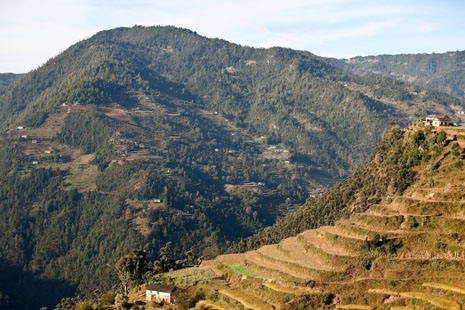
This view was the reason why we had choosen this route to Duble. Yesterday it was a little bit strange for our Nepalese staff - so close to the village and that strange client wants to stay for the night.
But, here, in the morning hours, the sun will be in the right position to take pictures of the slope with most of the houses of Duble and I expected that we would have a clear morning. I did not not find a detailed map of this area and therefore I intend to create a detailed panorama.
An ideal place for making that panorama is over there, at the right, near the house. I went there and made a series of 50 shots.
But, here, in the morning hours, the sun will be in the right position to take pictures of the slope with most of the houses of Duble and I expected that we would have a clear morning. I did not not find a detailed map of this area and therefore I intend to create a detailed panorama.
An ideal place for making that panorama is over there, at the right, near the house. I went there and made a series of 50 shots.
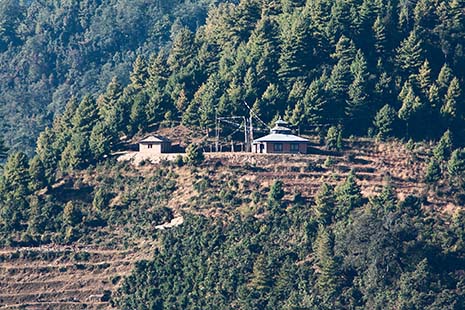
When I was in Duble, last year, in March, people were planning to build a kitchen near the gompa. Now, one and a half years later, that building is ready.
In the villages in the mountains not only Buddhism is very important, but also other religions and cultures. Besides monks and lamas also shamans are important members of the community. Duble is no exception. In these villages, the gompa also is a social center. For celebrations people gather there and eating together is often part of the celebration. So, a nearby kitchen is very practical. The food will still be hot when served. The building in Duble can also be used for other purposes.
In the villages in the mountains not only Buddhism is very important, but also other religions and cultures. Besides monks and lamas also shamans are important members of the community. Duble is no exception. In these villages, the gompa also is a social center. For celebrations people gather there and eating together is often part of the celebration. So, a nearby kitchen is very practical. The food will still be hot when served. The building in Duble can also be used for other purposes.
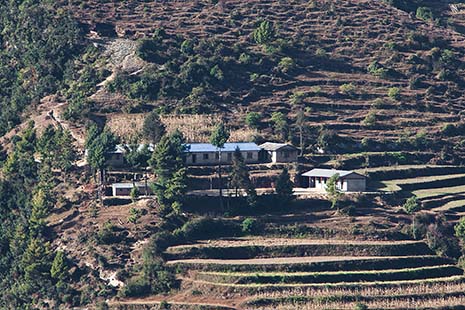
Here you will have recognized the school. The building at the right is also new. In the first room of this building the school board holds their meetings.
In the small building, left, are the toilets. I cannot wait to tell you that they were tidy and very well maintained. A few yards from the building is a water tap. One of these toilets was funded by Wouter ter Braek.
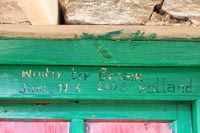 His name has been cut in the door frame, but for someone who did so much for the village, it should have been done nicer.
His name has been cut in the door frame, but for someone who did so much for the village, it should have been done nicer.
In the small building, left, are the toilets. I cannot wait to tell you that they were tidy and very well maintained. A few yards from the building is a water tap. One of these toilets was funded by Wouter ter Braek.

When you arrive in Duble and if you represent a foundation that helps people in the village, people prepare for you a festive welcome.
It is nice to feel that you are a welcome guest, especially since you notice that people really enjoy it to welcome you in this manner.
More pictures of my arrival in Duble (12).
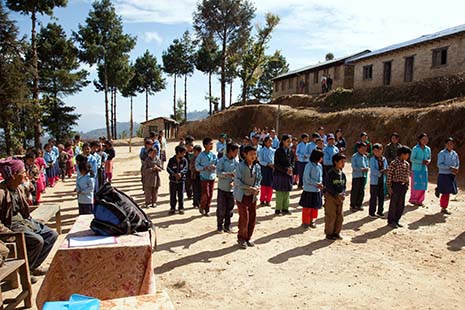
Next day, the welcome celebration is thoroughly addressed. The appointed time is 10 o'clock. So, everyone is present at eleven. Much has changed in eighteen months time. Not only is there now the building with the meeting room, but more important is that, with support from 'Stichting Sherpaland', the classrooms got wooden floors, doors and windows. The corrugated iron sheets on the roof are a gift of a British sponsor.
After a short time in the meeting room we move out with some tables and chairs. The children were assumed office on the playing ground and recite a text in Nepali. Then follows a lively event, in which the guests are honored with garlands of flowers and khatas. Of course, the speeches are not lacking. In these speeches gratitude and the hope for further assistance in the future is expressed.
After a short time in the meeting room we move out with some tables and chairs. The children were assumed office on the playing ground and recite a text in Nepali. Then follows a lively event, in which the guests are honored with garlands of flowers and khatas. Of course, the speeches are not lacking. In these speeches gratitude and the hope for further assistance in the future is expressed.
More pictures of the welcome celebration at the Jana Jyoti school (11).
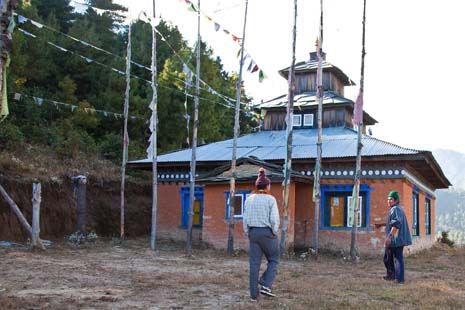
In the afternoon I go to the gompa. There is a puja in remembrance of the father of Homraj Tamang. Homraj is one of the teachers at the school. Although he did not receive any formal training in English language, he is also English teacher. He is not very happy about it, but there is currently no one else.
In the Gompa people are praying, share the latest news, have fun and enjoy a meal.
Pictures made during the puja in the Gompa (22).
In the Gompa people are praying, share the latest news, have fun and enjoy a meal.
Pictures made during the puja in the Gompa (22).
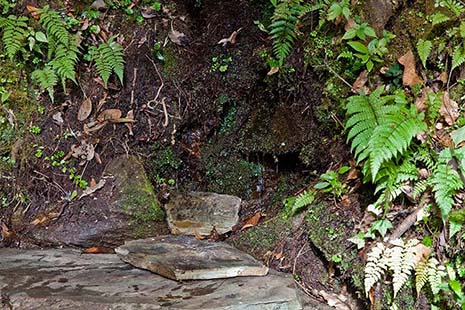
Next morning, Nang Sere Sherpa, Homraj Tamang and Kame Sherpa proudly show me the Pakhe drinking water project that was completed two months ago. The villagers have constructed this water supply with the financial support of 'Stichting Nijmegen Sherpaland'. What surprised me was that nowhere water is drained and filtered, but that water is taken directly from sources in the jungle.
Here you see the highest source. In the jungle the water is led, by pipes, to an assembly point 65 meters lower. From that point a wider pipe brings it to a large concrete buffer tank, which is 42 meters lower. Near this buffer tank is the first of 12 outlets. The lowest faucet, I have seen, was located 155 meters below the level of the buffer tank.
Here you see the highest source. In the jungle the water is led, by pipes, to an assembly point 65 meters lower. From that point a wider pipe brings it to a large concrete buffer tank, which is 42 meters lower. Near this buffer tank is the first of 12 outlets. The lowest faucet, I have seen, was located 155 meters below the level of the buffer tank.
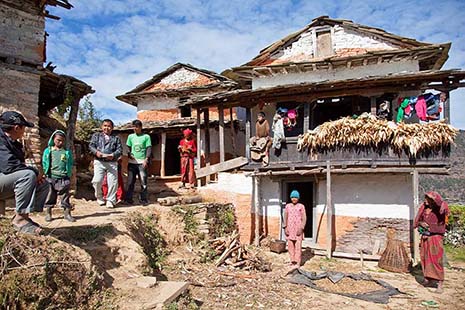
In this drinking water project, also the Dalit, an often disadvantaged caste of people, got a tap. I was lucky that when we arrived at their homes, someone was at work in the forge.
Pictures made in the forge (8).
Pictures made in the forge (8).
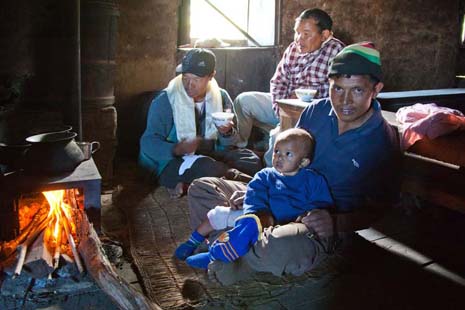
Saila and son visiting Kame's father, Rinji Sherpa.
Saila has been my porter many times, but only now I discovered that his official name is Bir Bahadur Tamang.
Now I could attend to the activity that was the most important for me - I visited almost all the people, who received one of our stoves or one of our solar panel installations.
I've noticed that the stoves properly comply. My cook, Karma Sherpa, felt that there was only one disadvantage, namely that children more easily burn themselves, because they have to learn that the thing can be hot at a spot, the stove pipe, where you do not see fire.
The 21 watt solar panels conform very well to the requirements. They are usually used with fluorescent tubes of 10 watts. LED bulbs are more expensive and the standard models are not as suitable for lighting rooms.
During my hike I have, successfully, used a homemade solar tuki. That, I left behind when I left Duble. I wonder how the receiver will rate it. The standard solar tuki includes two lamps with 12 LEDs each and a lead battery. Mine has two blocks of six rechargeable NiMH batteries, without carge controller, and a single lamp with two groups of 30 LEDs that can be switched on and off separately.
I've noticed that the stoves properly comply. My cook, Karma Sherpa, felt that there was only one disadvantage, namely that children more easily burn themselves, because they have to learn that the thing can be hot at a spot, the stove pipe, where you do not see fire.
The 21 watt solar panels conform very well to the requirements. They are usually used with fluorescent tubes of 10 watts. LED bulbs are more expensive and the standard models are not as suitable for lighting rooms.
During my hike I have, successfully, used a homemade solar tuki. That, I left behind when I left Duble. I wonder how the receiver will rate it. The standard solar tuki includes two lamps with 12 LEDs each and a lead battery. Mine has two blocks of six rechargeable NiMH batteries, without carge controller, and a single lamp with two groups of 30 LEDs that can be switched on and off separately.
While visiting Daputi Sherpa I get proof that the solar tuki's also comply. Her place could have been connected to 220 volts AC from the pico-hydroelectric power plant in Nayaban. That connection had not been taken because one had to pay NRs. 10.000,- as connection fee and should also pay for solving the frequent failures. The household consists of the two children we sponsor, a mother and her adult son, who is a widower, and a young woman who is widowed. Half of the residence was seized by the harvest.
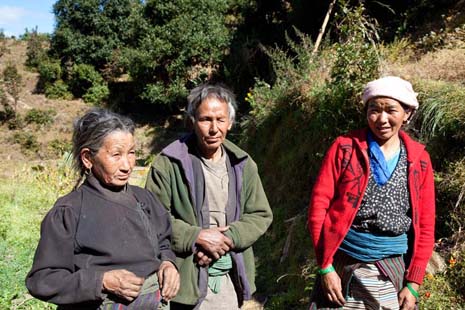
Daputi Sherpa and family
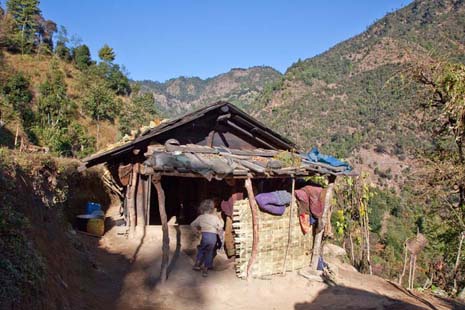
The house of Khadka Bahadur Tamang and his family. He lives here as a tennant, having no land. The Nepali used the word 'homeless' for this situation
Since all households with children sponsored by us, got at least a solar tuki, I also visited people who have a really low living standard. It is not my intention to document that situation, I try to show that it is easy to help a little bit. For my pictures I feel more attracted to the positive sides of life. I appreciate in the Nepalese that they really do their best to improve their situation. It is hard work.
Only at a few places I took pictures inside the houses, because in most cases, you can only go inside and stay longer when there are older people. The young tend to work somewhere outside on the land or even outside the village in the trekking industry. For many houses I recorded the GPS coordinates.
Only at a few places I took pictures inside the houses, because in most cases, you can only go inside and stay longer when there are older people. The young tend to work somewhere outside on the land or even outside the village in the trekking industry. For many houses I recorded the GPS coordinates.
Pictures made at the premises of the people who got a solar installation and/or a stove.
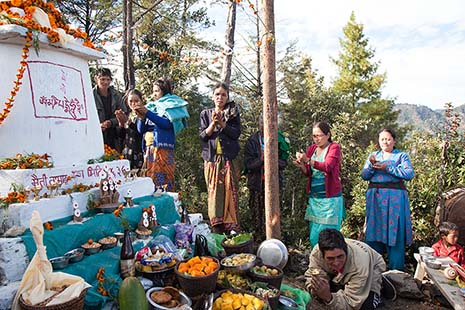
In the afternoon of my last day in Duble, I was a little bit tired and I felt that it was time to wash myself and some clothes. So I ask the cook to make a bowl of hot water. Kame did not suffer from fatigue and liked to make some pictures of the chorten, which Protiman had constructed in rememberance of his father. This chorten is now being inaugurated.
I decide not to join, because the chorten is 300 meters higher and after returning washing time will be over. Because the batteries in Kame's camera are almost empty, I give him my camera. So, the following pictures are made by Kame Sherpa.
Pictures made during the inauguration of a chorten.
I decide not to join, because the chorten is 300 meters higher and after returning washing time will be over. Because the batteries in Kame's camera are almost empty, I give him my camera. So, the following pictures are made by Kame Sherpa.
Pictures made during the inauguration of a chorten.